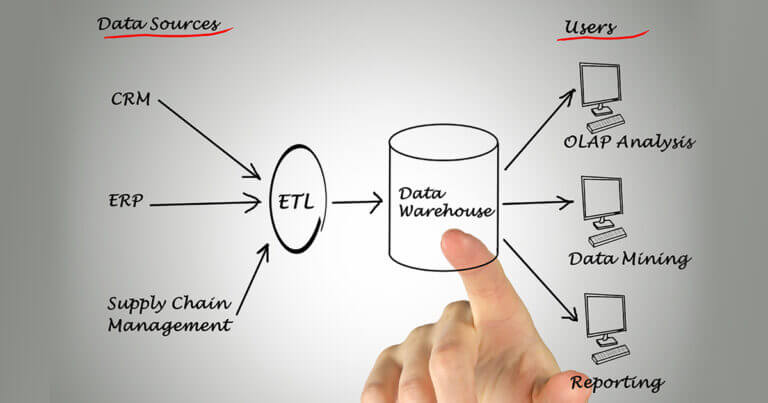The success of a project such as building a data warehouse development depends on your understanding of the business, its IT needs and pain points. Comprehending all these aspects help give businesses the structure it needs to be successful in data warehousing efforts. If you are going to get into data warehouse development, it is best to revisit these seven data warehouse best practices to save time in project development and cost optimization.
But before that, let’s understand what a data warehouse is and why it is crucial for companies.
What is a Data Warehouse?
A data warehouse is a centralized repository of data and information management systems. It amalgamates a company’s data from several sources in a single storage point. The main objective of it is to get the correct information to make substantiated decisions. Companies use this data or information to create analytical insights to understand business growth, performance and revenue over time.
How Does A Data Warehouse Work?
A data warehouse is designed to be a central repository that consolidates business or enterprise data from multiple sources. The data that flows within comes in all sorts and sizes, such as structured, semi-structured, and unstructured data. Moreover, these data may come from internal applications, customer-facing applications, and external systems.
Once the data enters into the data warehouse, it is not just stored there. The available data is sent for ingestion, transformation and processing and other predefined steps to come as processed data so as it could be accessed quickly and used for decision-making. Consolidating large quantities of information in the data warehouse, an organization can form a more holistic analysis to ensure that it has already considered all the available information before making a decision.
When Do You Need a Data Warehouse?
The key driver for most organizations building data warehouses is providing support to analytics platforms, including Tableau or Looker. Tableau and similar platforms perform heavy lifting jobs such as executing frequent and complex queries that put a lot of stress on a database. As a business’s availability highly relies on operational databases, it is hazardous to put stress on databases. On the other hand, data warehouses are modeled to respond to the stress or queries of BI engines.
Data Warehouse Best Practices
Now that we understand what a data warehouse is, how it works, and why companies need it, let’s jump on best practices that ensure the right start for your data warehouse development.
1. Finding Data Warehouse Need In Your Company
Many companies fail to identify a clear use case of business data. Companies that proactively invest time analyzing business problems for their data, and stay focused on finding a solution, are more likely to make the most of their strategy. Nonetheless, there are some key reasons why companies need a data warehouse. Let’s discuss them below:
Standardize your data – Data is stored in a standard format in data warehouses, for instance, tubular format. It makes access to data easier for authorized users in a company and enables them to collect actionable insights quickly. Storing data comes from multiple sources in a standardized format minimizes the risk of errors and improves accuracy.
Improve decision-making – Companies today rely on data-driven plans and strategies and are successful in their endeavors and innovation. Data warehousing helps them provide critical insights efficiently, build future strategy, and have the edge over the competition. If this is something you are expecting to infuse into your business, data warehousing is for you.
Reduce costs – It is possible to look into the historical data and evaluate the success and failure of past initiatives with the help of a data warehouse. Decision-makers can deep dive into the data, tweak their approach to reduce costs, increase operational efficiencies, drive growth, thereby improving the company’s bottom line.
2. Begin With Solid Master Data Management (MDM) Practices
Data accuracy is crucial to propose data-driven decisions within a firm. And to do this, it is essential to focus on having a solid master data management system in place. A Master data management system is a system that develops a controlled process to ensure only correct, consistent and validated master data is created. However, developing MDM is a challenge in itself because it has to ensure that only accurate master data is feeding the data warehouse. Therefore, MDM has to be a system that confirms the data quality of all data sources, stores data even in conditions when master data loss some data, and tracks data source anomalies. If implemented well, MDM reduces much of the transformation effort involved in populating warehouses.
3. Analyze How Frequently You Need to Load data
Identifying how frequently you need to load data helps you define data use-cases for your company. There is a way called batch processing which is used to process large volumes of data all at once when several transactions are collected over time. The process doesn’t require the specialized help of data entry personnel to support the functioning of batch processing that reduces operational costs of the company. Another way is real-time data processing that requires a continual input, process, and output of data. Real-time data processing provides real-time analytics enabling companies to take immediate action in business situations when timely action is important. Though batch processing is suitable for most organizations, real-time processing has its own use-cases within a firm.
4. Integrate Change Data Capture (CDC) Policy for Real-Time Data
If your requirements are real-time data processing, you must consider implementing a change data capture (CDC) policy for real-time data. CDC policy helps capture changes made to a database and assures that these changes are replicated in a data warehouse. As every change is captured, tracked and collected in relational tables, it provides a complete representation of historical data that has been modified in time. CDC is used as a highly efficient mechanism that diminishes the impact on the source when loading new data into your data warehouse. It also helps to populate real-time analytics dashboards and optimize data migrations strategy.
5. Prefer ELT Tools Instead Of ETL
ETL and ELT are the two popular data integration methods used in data warehouses. ETL stands for extract, transform, and load, whereas ELT stands for extract, load, and transform. Although both methods enable accumulating data from varied sources and putting it in a data warehouse, ELT offers flexibility and convenience of storing new, unstructured data. ELT allows storing all sorts of data, such as unstructured data offering instant access to all of your data and saves BI professional time while dealing with new information.
6. Define Permissions And Access Controls In Advance
A data warehouse is built of aggregated data collected from several sources. Reviewing the security needs of every source is a critical job where many organizations fail. Since data security and compliance requirements are crucial to maintain for any size of the firm, it is important to take time and assess privilege management and access control strategy with care at the beginning of the data ware development journey.
7. Considering Cloud
Cloud has become so advanced in today’s time and growing at a pace that it opens new opportunities for the IT requirements of a company. Setting up a data warehouse in the cloud could also be a good decision as you get better flexibility and ease to manage your data warehouse than on-premise. You can also leverage cloud data lakes that provide more general-purpose storage comprising big volumes of unstructured or semi-structured data before it’s prepared for analytic use in the data warehouse. Data warehouses hosted on the cloud provide better support for more complex analytic capabilities.
Conclusion
Documenting requirements in advance and setting up best practices for executing a project help save efforts and time to build a solution and help quickly bring the product to the market. If you are planning to build a data warehouse for your company, don’t forget to discuss these seven data warehouse best practices with the internal team and your outsourced consultants. It helps you get a clear picture of your end product and its deliveries.




